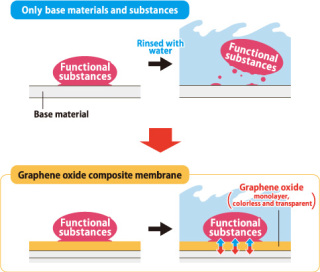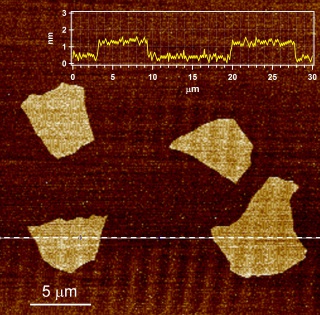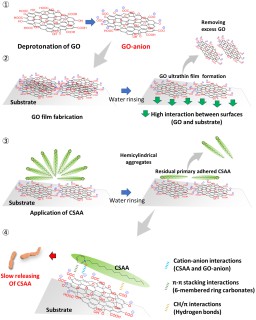Elucidating the substrate fixation mechanism of antimicrobial/antiviral agents by graphene oxide – Accelerating application in the antibacterial/antiviral fields –
- Management and Business
NIPPON SHOKUBAI CO., LTD. (Headquarters: Osaka, Japan; President: Kazuhiro Noda; hereinafter “Nippon Shokubai”) and a group led by Dr. Hirofumi Miyaji from the Department of Periodontics, Hokkaido University Hospital, announced last year that an antimicrobial/antiviral graphene oxide composite films with high water resistance and excellent fixation to substrates can be achieved.
News Release on October 14, 2021: https://www.shokubai.co.jp/en/news/news0283.html
A group led by Professor Hideya Kawasaki of the Faculty of Chemistry, Materials and Bioengineering, Kansai University, has now been added to further investigate this technology and material, and has elucidated the substrate fixation mechanism of antimicrobial/antiviral agents by graphene oxide, and the long-term antimicrobial/antiviral effects of graphene oxide composite films. The content related to this release was published in Scientific Reports on October 18, 2022 (For the detail, please refer to “Paper Information” on page 4).
[Substrate fixation mechanism of antimicrobial/antiviral agents by graphene oxide]
Although the functional substance by itself has low adhesion to substrates, when combined with graphene oxide, substrate adhesion (water resistance and long-term stability) is improved (Fig. 1).
In order to widely disseminate these technologies in industry, it was necessary to elucidate the mechanism and develop more effective methods of use. However, the mechanisms of water resistance and long-lasting antibacterial/antiviral effects have not been clarified in detail. In response to these issues, Nippon Shokubai, Dr. Miyaji’s group, and Dr. Kawasaki’s group have conducted detailed tests and analyses to estimate the interaction that causes the water resistance and to elucidate the mechanism that causes the antibacterial and antiviral properties.
[Mechanism of water resistance and antibacterial/antiviral effects]
■Graphene oxide was strongly adsorbed to the substrate, and a monolayer film of graphene oxide was formed on the substrate surface.
■Graphene oxide on the substrate and antibacterial/antiviral agents were firmly adsorbed by multiple interaction mechanisms, resulting in high water resistance.
■The antibacterial/antiviral agents were released slowly and exerted long-term antibacterial/antiviral effects.
Figure 2 shows the mechanism of water resistance and antibacterial/antiviral properties of graphene oxide (GO) and antibacterial/antiviral agents’ (cationic surface active agents: CSAA)*1 composite films.
(1) Graphene oxide releases protons in water and assumes an anionic structure (negatively charged).
(2) In addition to the anionic structure, the sheet structure allows them to adsorb strongly to the substrate due to the high interaction of ionic interactions*2 and van der Waals forces*3. Excess graphene oxide that is not in contact with the substrate has weak interactions and can be easily removed by rinsing with water.
(3) When an antimicrobial/antiviral agent is applied to graphene oxide on the substrate, the antimicrobial/antiviral agent on the top surface adsorbs the entire molecule along the molecular chain. However, the antimicrobial/antiviral agent that existed above the substrate cannot interact with graphene oxide and forms a micelle-like structure*4 with weak force. The excess antimicrobial/antiviral agent can also be easily removed by rinsing with water.
⇒The antibacterial/antiviral agents remaining on the top surface were found to be strongly combined through multiple interactions such as ionic interactions, van der Waals forces, π-π interactions*5, and CH/π interactions*5 from various analyses. This is thought to result in strong adsorption to the substrate via graphene oxide and to high water resistance.
(4) The antibacterial/antiviral agents are released slowly and exert long-term antibacterial and antiviral effects.
[Graphene oxide]
Graphene oxide is a type of nanocarbon material and has a high aspect ratio sheet structure with 1 nm thickness and width of several micrometers (Fig. 1). The effectiveness of graphene oxide has been confirmed in various uses, and it is expected to be applied in a wide range of fields. However, mass production on an industrial scale has been difficult. Using the techniques we have accumulated to safely and stably control chemical reactions in chemical production, Nippon Shokubai has solved various issues in graphene oxide mass production and established mass production technology.
The knowledge gained can be applied for various base materials and antibacterial/antiviral agents. We are promoting the commercialization of graphene oxide in the antibacterial/antiviral fields through sample works for various users.
*1 The antibacterial/antiviral agents used in this paper were benzalkonium chloride, cetylpyridinium chloride, and benzethonium chloride, which are commonly used as antibacterial/antiviral agents.
*2 Force of attraction between positive and negative charges
*3 Forces acting between various atoms, ions, and molecules
*4 Aggregated structures of the hydrophobic portion of CSAA in water
*5 Interactions between molecules with particular structures (electronic state)
【Paper information】
Title: Sustained antibacterial coating with graphene oxide ultrathin film combined with cationic surface-active agents in a wet environment
Authors: Hirofumi Miyaji, Yukimi Kanemoto, Asako Hamamoto, Kanako Shitomi, Erika Nishida, Akihito Kato, Sugaya Tsutomu, Saori Tanaka, Natsuha Aikawa, Hideya Kawasaki, Syun Gohda, Hironobu Ono
Journal: Scientific Reports (2022.10.18 Published)
URL: https://www.nature.com/articles/s41598-022-21205-4
*Effects such as “not removed by rinsing with water,” “water resistance,” and “antibacterial/antiviral properties” were confirmed for the substrate and conditions under which the experiments related to this release were conducted. The same effects may not be obtained with all materials and environments.
About NIPPON SHOKUBAI: Since 1941, Nippon Shokubai has grown up its business with unique catalyst technology. Nippon Shokubai has supplied, for example, ethylene oxide, acrylic acid, automobile catalysts, process catalysts and so on. Among all, our global market share of superabsorbent polymers is the largest in the world now (according to Nippon Shokubai research). Nippon Shokubai is a global chemical company operating under its corporate mission “TechnoAmenity: Providing prosperity and comfort to people and society, with our unique technology.”
https://www.shokubai.co.jp/en/
【Contacts】
Corporate Communications Dept.,
NIPPON SHOKUBAI CO., LTD.
TEL: +81-3-3506-7605 E-mail: shokubai@shokubai.co.jp



[Files]